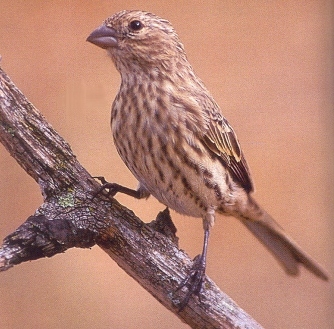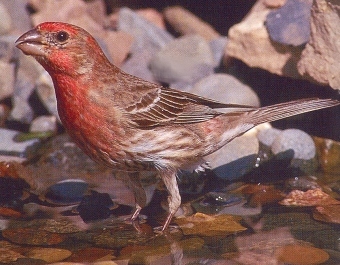|

Medium-sized finch
with brown-streaked back and wings, and brown-streaked white underparts.
Head, throat, and rump are pink-red. Tail is relatively long and weakly
notched. Bill is short and slightly decurved. Feeds mostly on seeds,
takes some insects and fruits. Swift bounding flight.
The male House Finch has a brown-streaked back and wings and streaked
white underparts. Head, throat, and rump are pink-red.
|
HOUSE
FINCH
Carpodacus mexicanus
PASSERIFORMES
Finches (Fringillidae)
Range and Habitat
Resident throughout the west, from southern Canada to southern Mexico,
and east to Nebraska. Introduced to eastern North America, where it
is now widespread in cities and residential areas. In the west, preferred
habitats include chaparral, deserts, orchards, and suburban areas.
SOUND:
"zeeeeee"
The coloring of the male House Finch can range from deep red to golden
yellow, depending on available diet during molting.
Originally they were brought from the Southwest to Long Island as caged
birds. In 1940, a small population was released into the wild and flourished.
They have since spread throughout the eastern and Midwestern United
States.

Considered a pest by some, they are susceptible to chronic infections
that can spread to other feeder visitors and commercial poultry. A group
of house finches are collectively known as a "development"
of finches.
The House Finch currently has a rating of Least Concern. This is a downgraded
rating from a 2000 rating of Lower Risk. At this time there are no immediate
concerns or threats regarding this bird species due to the fact that
both the population and the range of this bird are large enough for
there to be no concerns regarding decline. The House Finch has a range
of nearly 8 million kilometers.

|